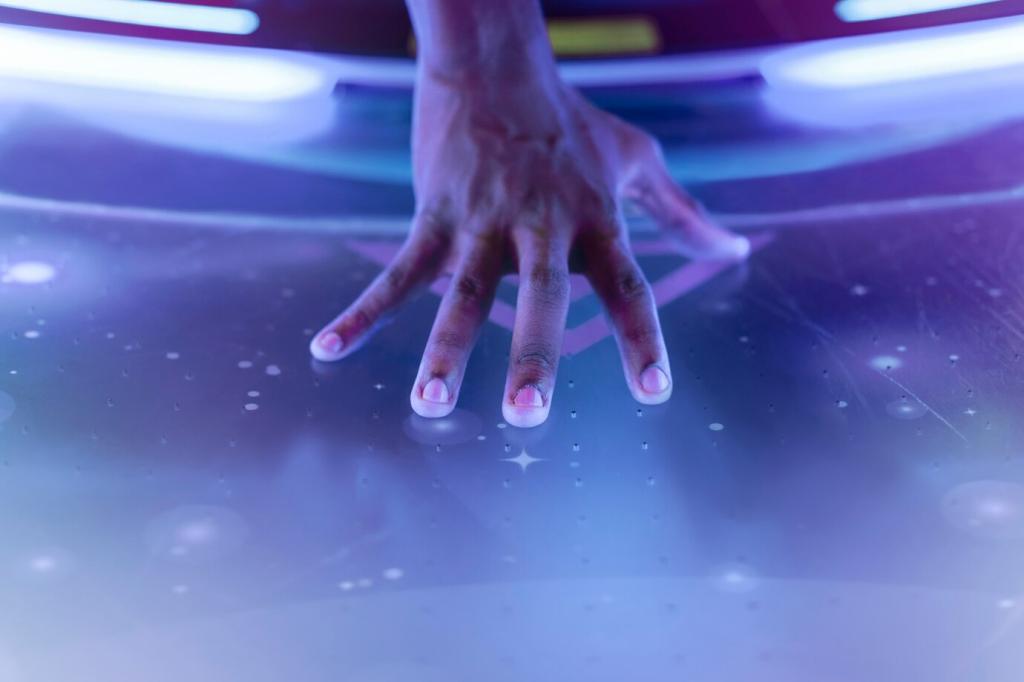Tech-Infused Fashion Trends
Smart Fabrics and Textiles
01
Sensing and Adaptive Materials
In the world of smart textiles, materials can detect changes in temperature, moisture, and light, adapting their properties accordingly. Imagine a jacket that gets warmer as the temperature drops or activewear that becomes more breathable when you sweat. Using embedded microfibers and nanotechnology, these advanced fabrics monitor the wearer’s body and the surrounding environment. This dynamic responsiveness not only increases comfort but also offers health benefits and convenience, transforming clothing into active participants in our daily lives.
02
Conductive Threads and Wearable Electronics
The infusion of conductive materials into textiles allows the creation of garments equipped with electronic capabilities. Conductive threads stitched into fabric create flexible circuits that can power LEDs, connect sensors, or enable wireless communication. This enables designers to embed touch controls, heating elements, or even flexible displays directly into clothing without compromising comfort or style. The transparent integration of electronics into fashion offers new forms of utility, from illuminated jackets to dresses that change color with a tap.
03
Energy-Generating Garments
Harnessing movement and the elements, some tech-infused textiles generate power from the wearer’s activity or environment. Solar fibers or piezoelectric materials are woven into fabrics, capturing sunlight or kinetic energy and converting it into electricity. These garments can charge mobile devices or power embedded sensors, bringing a new level of self-sufficiency and eco-friendliness to personal electronics. As this technology matures, the vision of energy-harvesting fashion is becoming a practical way to support our increasingly connected lifestyles.
Clothing equipped with discreet biosensors now monitors heart rate, muscle activity, breathing, and even hydration levels. Unlike traditional wristbands, these garments provide deeper, more accurate data by sitting directly against the skin and covering larger surface areas. From smart yoga pants that track posture to T-shirts monitoring cardiac activity, wearables are transforming how we understand and improve our health, making the tracking experience more comfortable and seamlessly integrated into daily routines.


On-Demand Manufacturing
Traditional fashion production often leads to surplus and waste. With 3D printing, pieces are created on demand, reducing excess inventory and environmental impact. This approach also allows for hyper-local manufacturing, where garments are printed at or near the point of sale. Brands can rapidly respond to trends or customer feedback, offering fresh designs without the delays and risks associated with mass production, resulting in a more agile and sustainable fashion ecosystem.
Personalized Fit and Design
3D printing enables clothes and accessories to be made specifically for an individual’s body measurements and personal taste. From perfectly fitted shoes to intricately patterned dresses, this technology puts personalization at the forefront of fashion. By scanning the wearer’s body, designers can craft garments that enhance comfort, fit, and style—boosting confidence and satisfaction while minimizing the need for alterations.
Innovation in Materials and Structures
3D printers can create complex geometric shapes and unique textures that are impossible to achieve through traditional manufacturing. Designers experiment with unconventional materials, such as flexible polymers or biodegradable compounds, producing avant-garde statements or highly functional components. From futuristic haute couture to adaptive prosthetic limbs disguised as jewelry, this innovative approach broadens the creative horizons of what fashion can become.
Sustainable and Ethical Innovations
Eco-Friendly Materials and Processes
Advances in biotechnology and materials science have led to the creation of fabrics derived from renewable resources or recycled waste. Lab-grown leather, spider silk, and plant-based polymers are just a few examples of innovations replacing traditional, resource-intensive materials. These solutions reduce dependence on animal products and harmful chemicals, offering designers a new palette for creativity while supporting a healthier planet.
Transparent Supply Chains
Blockchain technology and digital tagging are revolutionizing the traceability of fashion products. By providing a transparent record of every stage, from raw materials to finished product, consumers can identify the origins of their garments and verify ethical sourcing. This eliminates greenwashing and holds brands accountable, empowering shoppers to make informed decisions and encouraging the industry to adopt fair labor practices and environmental stewardship.
Reduction of Waste Through Digital Solutions
The digitization of pattern-making and virtual sampling means fewer physical prototypes and less waste. AI-driven design tools predict optimal fabric usage, minimizing offcuts and unsold inventory. Virtual fitting rooms and made-to-order models further decrease returns and overproduction. In effect, technology is helping transform the fast-fashion cycle into a more mindful, waste-efficient process, balancing innovation with responsibility.

Digital Fashion and Virtual Runways
Consumers now purchase digital-only garments to dress their avatars in video games and share on social media. These virtual pieces, untethered from physical constraints, allow for creative, bold designs that defy the limits of real-world physics and manufacturing. This trend fuels a new kind of self-expression and reduces the environmental impact of fast-fashion cycles, as style becomes an experience rather than a possession.
Artificial Intelligence in Design
AI-Assisted Creative Process
Machine learning algorithms can generate patterns, suggest color palettes, and identify design elements likely to capture consumer attention. Designers use AI to experiment rapidly, creating hundreds of prototypes digitally before physical production. This infusion of data-driven insight accelerates innovation while giving creative professionals powerful new tools to turn inspiration into reality at unprecedented speed and scale.
Personalized Shopping and Style Recommendations
AI powers digital stylists and recommendation engines, analyzing user preferences, body type, and lifestyle to suggest products that suit each individual perfectly. Consumers receive curated selections and virtual try-on options, reducing decision fatigue and increasing satisfaction. Retailers benefit from improved conversion rates and customer loyalty, as AI makes discovering new styles intuitive and tailored to each shopper.
Predicting Trends and Optimizing Inventory
By analyzing vast data sets from social media, sales, and global events, AI can forecast fashion trends months before they peak. Brands use this intelligence to optimize inventory, minimize overproduction, and react swiftly to changing consumer demands. As a result, businesses can operate more efficiently, reduce risk, and offer collections that resonate more effectively with the market.
Fashion in the Age of Connectivity

Socially Connected Clothing
Some garments now enable wearers to communicate with others through embedded technology, such as sending digital messages or coordinated light displays. Couples may synchronize jewelry to pulse gently when they’re thinking of one another, or entire crowds might participate in a collective visual display at an event. This new dimension of social connectivity extends fashion’s traditional role as a conversational and expressive tool, amplifying its impact through digital channels.

Real-Time Data Integration
Clothing equipped with IoT sensors can provide real-time feedback on the wearer’s environment and personal state. For instance, jackets that display pollution levels or running shirts that signal hydration reminders connect wearers more intimately with both their own bodies and the world around them. These integrations enhance safety, well-being, and convenience, demonstrating technology’s ability to blend seamlessly with our daily routines.

Interactive Fashion Experiences
Brands are exploring garments and accessories that change appearance or function in response to external cues—such as shifting color when exposed to sunlight or syncing patterns with music at a live event. These interactive experiences turn fashion into a form of entertainment, personal storytelling, and even live performance, inviting wearers and observers to engage with clothing in new and memorable ways.
